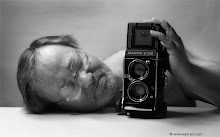Do you know this?
This time I've seen videos about Lumen-Prints.
Analoge photography on light-sensitive photo-papier without chemicals?
Wow, what colors, what posibilities. So I took 3 of my old 9 x 12 cm - Cameras and start in the middle of night with Lumen-Photography.
 |
| Camera & Object (with day-light) |
The problem: it was impossible to find the right field of sharpness on the screen. It was really too dark... But I didn't like to wait, and wanted to go to bed.
I hoped to get some marvellouse Lumen-Prints when I get up at high noon...
This was the theory...
But what I've got, was that:
 |
| Lumenprint on photo-paper, exposing time about 7 hrs. |
Ok.
It is the negative, but where are the colors?
Later, I find out, that the colors are on this black/white-photo-paper, but only very, very light.
The next step was, to make some digitally "remasterings".
 |
| The same Lumenprint, after the digital-process. |
Now I take a new photo on usually light-sensitive foto-paper, in the daylight, exposure-time = 40 minutes.
 |
| Lumenprint, 40 min. after fixing (yes, with chemicals) and additional exposing with UV-light. |
 |
| Photo from above, after digital inverting. |
 |
| Digital print from the same photo, after playing with photoshop and so. |
 |
| Same photo. After I've find out, how to manipulate and controll the colors. |
...and your Lumen-Prints?
Show me ;-)
-ekk-











